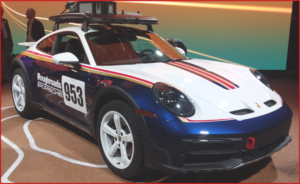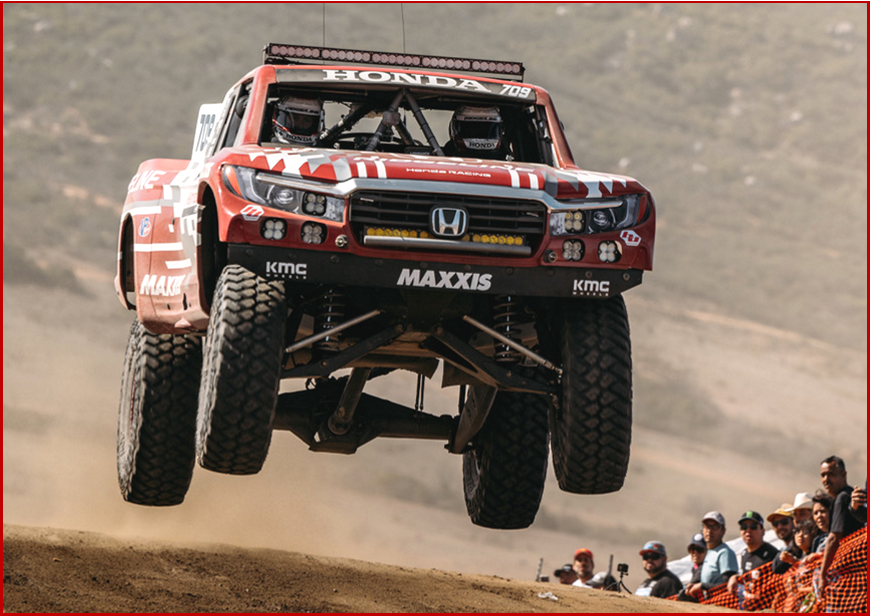
Click for more information.
While Porsche is celebrating the world premiere at the Los Angeles Auto Show this week of the new Porsche 911 Dakar, a Honda Ridgeline Baja Race Truck took Class 7 honors for the second consecutive year in the 55th running of the Baja 1000, which ended yesterday.
Welcome to the confusing world of performance car and truck racing and production car and truck marketing. There are clear differences in the vehicles, but the promotional aspects are virtually identical.
Porsche claims the 911 Dakar is just as comfortable off-road as it is on the 405 interstate. Limited to just 2,500 examples, the marketing of this saleable street machine suggests the first overall victory by Porsche in the 1984 Paris-Dakar Rally, which marked the birth of all-wheel-drive in the Porsche 911.
This is why the new 911 Dakar is also offered with an optional Rally Design Package, reminiscent of that winning car. The two-tone paint is in White/Enzian Blue Metallic. This is the first time Porsche has applied the combination of bi-color paint and decorative foiling in series production. Oh, one more thing for wannabes: On the side of the vehicle, the customer can choose an individual race number between 0 and 999.

Click for more information.
The Honda Ridgeline Baja Race Truck is a race horse of a different color. It was the eighth win for the Honda Ridgeline in Baja since the start of the program in 2015. It uses the same production-based, Honda Performance Development built turbocharged V6 engine that also powered this year’s entries in the IMSA WeatherTech SportsCar Championship and Rolex 24 at the Daytona-winning Meyer Shank Racing Acura ARX05, driven by Tom Blomqvist, Helio Castroneves and Oliver Jarvis.
The somewhat related (distant, many times removed cousin?) 3.5-liter production engine powers a variety of Honda and Acura passenger vehicles, including the Acura MDX and Honda Ridgeline.
The Porsche 911 Dakar has a 3-liter bi-turbo six-cylinder with 480 PS (353 kW or 473 horsepower) and a maximum torque of 570 Newton-meters (420 lb. ft.) with it’s said the well-known boxer whoosh sound. The new sports car arrives at 100 km/h in 3.4 seconds. However, because of its all-terrain tires, top speed is limited to 240 km/h.
The tires are racing-developed Pirelli Scorpion All Terrain Plus tires (245/45 ZR 19 at the front, 295/40 ZR 20 at the rear). The coarse tread pattern is nine millimeters deep and the reinforced sidewalls and the threads consist of two carcass plies. Porsche says these tires on the 911 Dakar are ideal for challenging terrain and they are highly cut-resistant. Pirelli P Zero summer and winter tires are available as an option, also with two carcass plies. But the all-terrain tires come as standard and offer what’s said to be sports car dynamics on the road as well.
As standard, the engine comes with an eight-speed PDK and Porsche all-wheel drive. The standard equipment also includes rear-axle steering, the engine mounts from the 911 GT3, and PDCC anti-roll stabilization.
“The interplay of all the components results in the 911 Dakar being just as dynamic on sand and loose surfaces as it is on the Nürburgring Nordschleife. Maximum off-road performance is also ensured by two new driving modes, which can be selected using the rotary switch on the steering wheel. Rally mode is ideal for loose, uneven surfaces and features rear-focused all-wheel drive. In off-road mode the high clearance is activated automatically. This mode is designed for maximum traction on difficult terrain and on sand. Both of the new driving modes also feature the new Rally Launch Control, which enables impressive acceleration on loose surfaces and allows wheel slippage of around 20%,” Porsche said at an event on the eve of the LA Auto Show.

About Ken Zino
Ken Zino, editor and publisher of AutoInformed, is a versatile auto industry participant with global experience spanning decades in print and broadcast journalism, as well as social media. He has automobile testing, marketing, public relations and communications experience. He is past president of The International Motor Press Assn, the Detroit Press Club, founding member and first President of the Automotive Press Assn. He is a member of APA, IMPA and the Midwest Automotive Press Assn.
He also brings an historical perspective while citing their contemporary relevance of the work of legendary auto writers such as Ken Purdy, Jim Dunne or Jerry Flint, or writers such as Red Smith, Mark Twain, Thomas Jefferson – all to bring perspective to a chaotic automotive universe.
Above all, decades after he first drove a car, Zino still revels in the sound of the exhaust as the throttle is blipped during a downshift and the driver’s rush that occurs when the entry, apex and exit points of a turn are smoothly and swiftly crossed. It’s the beginning of a perfect lap.
AutoInformed has an editorial philosophy that loves transportation machines of all kinds while promoting critical thinking about the future use of cars and trucks.
Zino builds AutoInformed from his background in automotive journalism starting at Hearst Publishing in New York City on Motor and MotorTech Magazines and car testing where he reviewed hundreds of vehicles in his decade-long stint as the Detroit Bureau Chief of Road & Track magazine. Zino has also worked in Europe, and Asia – now the largest automotive market in the world with China at its center.


Porsche Showing 911 Dakar at LA. Honda Wins Baja 1000
Click for more information.
While Porsche is celebrating the world premiere at the Los Angeles Auto Show this week of the new Porsche 911 Dakar, a Honda Ridgeline Baja Race Truck took Class 7 honors for the second consecutive year in the 55th running of the Baja 1000, which ended yesterday.
Welcome to the confusing world of performance car and truck racing and production car and truck marketing. There are clear differences in the vehicles, but the promotional aspects are virtually identical.
Porsche claims the 911 Dakar is just as comfortable off-road as it is on the 405 interstate. Limited to just 2,500 examples, the marketing of this saleable street machine suggests the first overall victory by Porsche in the 1984 Paris-Dakar Rally, which marked the birth of all-wheel-drive in the Porsche 911.
This is why the new 911 Dakar is also offered with an optional Rally Design Package, reminiscent of that winning car. The two-tone paint is in White/Enzian Blue Metallic. This is the first time Porsche has applied the combination of bi-color paint and decorative foiling in series production. Oh, one more thing for wannabes: On the side of the vehicle, the customer can choose an individual race number between 0 and 999.
Click for more information.
The Honda Ridgeline Baja Race Truck is a race horse of a different color. It was the eighth win for the Honda Ridgeline in Baja since the start of the program in 2015. It uses the same production-based, Honda Performance Development built turbocharged V6 engine that also powered this year’s entries in the IMSA WeatherTech SportsCar Championship and Rolex 24 at the Daytona-winning Meyer Shank Racing Acura ARX05, driven by Tom Blomqvist, Helio Castroneves and Oliver Jarvis.
The somewhat related (distant, many times removed cousin?) 3.5-liter production engine powers a variety of Honda and Acura passenger vehicles, including the Acura MDX and Honda Ridgeline.
The Porsche 911 Dakar has a 3-liter bi-turbo six-cylinder with 480 PS (353 kW or 473 horsepower) and a maximum torque of 570 Newton-meters (420 lb. ft.) with it’s said the well-known boxer whoosh sound. The new sports car arrives at 100 km/h in 3.4 seconds. However, because of its all-terrain tires, top speed is limited to 240 km/h.
The tires are racing-developed Pirelli Scorpion All Terrain Plus tires (245/45 ZR 19 at the front, 295/40 ZR 20 at the rear). The coarse tread pattern is nine millimeters deep and the reinforced sidewalls and the threads consist of two carcass plies. Porsche says these tires on the 911 Dakar are ideal for challenging terrain and they are highly cut-resistant. Pirelli P Zero summer and winter tires are available as an option, also with two carcass plies. But the all-terrain tires come as standard and offer what’s said to be sports car dynamics on the road as well.
As standard, the engine comes with an eight-speed PDK and Porsche all-wheel drive. The standard equipment also includes rear-axle steering, the engine mounts from the 911 GT3, and PDCC anti-roll stabilization.
“The interplay of all the components results in the 911 Dakar being just as dynamic on sand and loose surfaces as it is on the Nürburgring Nordschleife. Maximum off-road performance is also ensured by two new driving modes, which can be selected using the rotary switch on the steering wheel. Rally mode is ideal for loose, uneven surfaces and features rear-focused all-wheel drive. In off-road mode the high clearance is activated automatically. This mode is designed for maximum traction on difficult terrain and on sand. Both of the new driving modes also feature the new Rally Launch Control, which enables impressive acceleration on loose surfaces and allows wheel slippage of around 20%,” Porsche said at an event on the eve of the LA Auto Show.
About Ken Zino
Ken Zino, editor and publisher of AutoInformed, is a versatile auto industry participant with global experience spanning decades in print and broadcast journalism, as well as social media. He has automobile testing, marketing, public relations and communications experience. He is past president of The International Motor Press Assn, the Detroit Press Club, founding member and first President of the Automotive Press Assn. He is a member of APA, IMPA and the Midwest Automotive Press Assn. He also brings an historical perspective while citing their contemporary relevance of the work of legendary auto writers such as Ken Purdy, Jim Dunne or Jerry Flint, or writers such as Red Smith, Mark Twain, Thomas Jefferson – all to bring perspective to a chaotic automotive universe. Above all, decades after he first drove a car, Zino still revels in the sound of the exhaust as the throttle is blipped during a downshift and the driver’s rush that occurs when the entry, apex and exit points of a turn are smoothly and swiftly crossed. It’s the beginning of a perfect lap. AutoInformed has an editorial philosophy that loves transportation machines of all kinds while promoting critical thinking about the future use of cars and trucks. Zino builds AutoInformed from his background in automotive journalism starting at Hearst Publishing in New York City on Motor and MotorTech Magazines and car testing where he reviewed hundreds of vehicles in his decade-long stint as the Detroit Bureau Chief of Road & Track magazine. Zino has also worked in Europe, and Asia – now the largest automotive market in the world with China at its center.